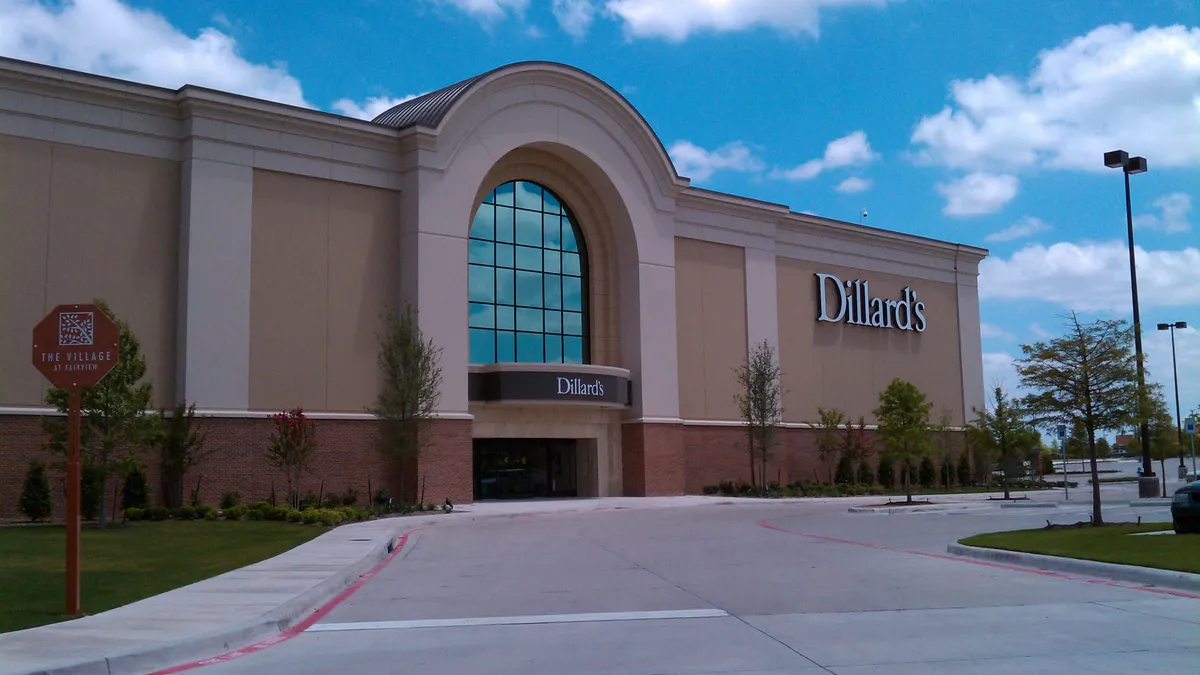Dive Brief:
-
Dillard's on Thursday did the department store segment proud, with total third quarter retail sales up 47% year over year and 9% from 2019 to $1.46 billion. Total retail sales don't include the company's construction business.
-
Store comps rose 48% year over year and 12% from 2019, with sales of juniors and children's apparel and men's apparel and accessories "significantly" outperforming other categories compared to two years ago, according to a company press release.
-
Net income soared 518% year over year to $197.3 million, thanks in part to a net tax benefit of $32.4 million from the Coronavirus Aid, Relief and Economic Security Act. Retail gross margin (excluding construction sales) expanded to 46.7% from 36.6% a year ago, a 1,221 basis point jump from 2019, the company said.
Dive Insight:
Department stores are basking in this year's rebound in shopping generally and apparel especially, but aren't seeing much improvement over their pre-pandemic performances. Dillard's, however, has often been a standout in a sector that has experienced years of decline, and that's holding true this year.
In a statement, CEO William Dillard called the period "another record quarter," noting that the company is sitting on $620 million in cash even after repurchasing $239 million of stock. Unfortunately for rivals, Dillard's performance doesn't necessarily serve as a harbinger for department stores more generally.
"I think Dillard's fulfills the axiom, 'all retail is local,'" retail consultant Brian Kelly, a veteran of the department store business, said by email. "Dillard's remains a relevant brand to its constituency. And it's been properly managed — both selling and business models are in synch. It succeeds in Southern markets with healthier local economies."
Still, Dillard's does face many of the challenges of the department store model, including an older customer base, overly big stores and a dependence on apparel. That means that even Dillard's performance will return to Earth, according to GlobalData Managing Director Neil Saunders.
"We certainly do not believe that sales will completely collapse, but we do think growth will come down to much more modest levels," he said in emailed comments. "In the medium-term the trajectory to Dillard's will go back to where it was before the pandemic: flat at best, with occasional declines."
Saunders concurs that "the prognosis for Dillard's is not nearly as negative as that for other department stores," in large part because it's good at retail fundamentals. "Stores are usually neat, customer service is good, and assortments are reasonable," Saunders said. "The management team may not be the greatest innovators in the retail world, but they have a strong understanding of the sector and, most importantly, have high standards."
Supply chain challenges have been a double-edged sword — lean inventory has meant fewer markdowns but also empty shelves. That emptiness also stems from another department store challenge: oversized stores.
"A lot of Dillard's were built for a different era and the huge amount of space is simply no longer needed or relevant," Saunders said. "This is especially so as some categories, like formal suiting, which are now in decline. The company needs to think creatively about how to address this."
Similarly, the retailer could do better online, and work harder to attract younger consumers, especially since its actual assortment does include many goods relevant to those shoppers, Saunders also said.












